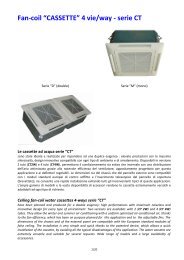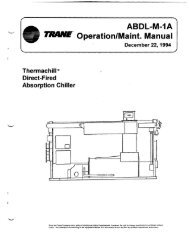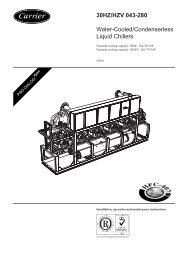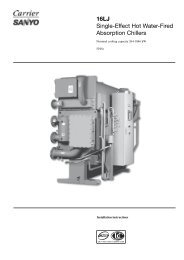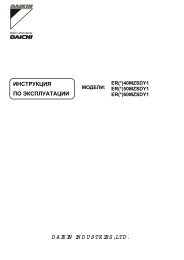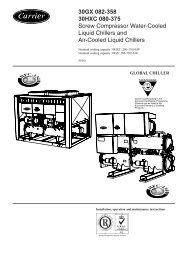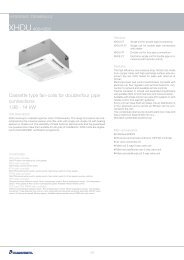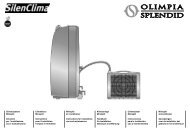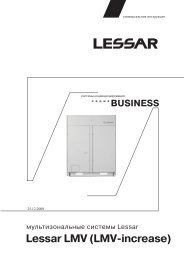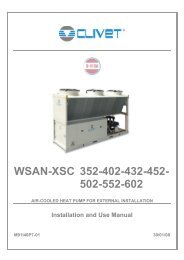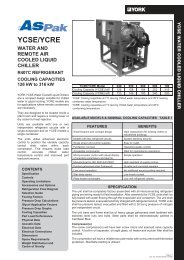"A" Ductable Liquid Chillers with Integrated Hydronic Module
"A" Ductable Liquid Chillers with Integrated Hydronic Module
"A" Ductable Liquid Chillers with Integrated Hydronic Module
Create successful ePaper yourself
Turn your PDF publications into a flip-book with our unique Google optimized e-Paper software.
9 - WATER CONNECTIONSFor size and position of the unit water inlet and outlet connectionsrefer to the certified dimensional drawings supplied <strong>with</strong>the unit. The water pipes must not transmit any radial or axialforce to the heat exchangers nor any vibration.The water supply must be analysed and appropriate filtering,treatment, control devices, shutoff and bleed valves and circuitsbuilt in, to prevent corrosion (example: damage to the protectionof the tube surface if the fluid is polluted), fouling and deteriorationof the pump fittings.Before any start-up verify that the heat exchange fluid iscompatible <strong>with</strong> the materials and the water circuit coating.In case additives or other fluids than those recommended byCarrier s.a are used, ensure that the fluids are not considered asa gas, and that they belong to class 2, as defined in directive97/23/EC.Carrier s.a. recommendations on heat exchange fluids:1. No NH 4+ ammonium ions in the water, they are verydetrimental for copper. This is one of the most importantfactors for the operating life of copper piping. A contentof several tenths of mg/l will badly corrode the copperover time.2. Cl - Chloride ions are detrimental for copper <strong>with</strong> a risk ofperforations by corrosion by puncture. If possible keepbelow 10 mg/l.3. SO 42-sulphate ions can cause perforating corrosion, iftheir content is above 30 mg/l.4. No fluoride ions (2.8 K. Values between 10 and 25can be recommended. This will facilitate scale deposit thatcan limit corrosion of copper. TH values that are too highcan cause piping blockage over time. A total alkalimetrictitre (TAC) below 100 is desirable.8. Dissolved oxygen: Any sudden change in water oxygenationconditions must be avoided. It is as detrimental todeoxygenate the water by mixing it <strong>with</strong> inert gas as it isto over-oxygenate it by mixing it <strong>with</strong> pure oxygen. Thedisturbance of the oxygenation conditions encouragesdestabilisation of copper hydroxides and enlargement ofparticles.9. Specific resistance – electric conductivity: the higher thespecific resistance, the slower the corrosion tendency.Values above 3000 Ohm/cm are desirable. A neutralenvironment favours maximum specific resistance values.For electric conductivity values in the order of 200-6000S/cm can be recommended.10. pH: Ideal case pH neutral at 20-25°C (7 < pH < 8).ATTENTION: Charging, adding or draining fluid from thewater circuit must be done by qualified personnel, using airvents and materials suitable for the products. The watercircuit charging devices are field-supplied.Charging and removing heat exchange fluids should be done<strong>with</strong> devices that must be included on the water circuit by theinstaller. Never use the unit heat exchangers to add heatexchange fluid.9.1 - Operating precautions and recommendationsThe water circuit should be designed to have the least numberof elbows and horizontal pipe runs at different levels. Belowthe main points to be checked for the connection:• Comply <strong>with</strong> the water inlet and outlet connections shownon the unit.• Install manual or automatic air purge valves at all highpoints in the circuit.• Use an expansion device to maintain pressure in thesystem and install a safety valve as well as an expansiontank.Units <strong>with</strong> a hydronic module include the safety valve andthe expansion tank.• Install thermometers in both the entering and leavingwater connections.• Install drain connections at all low points to allow thewhole circuit to be drained.• Install stop valves, close to the entering and leaving waterconnections.• Use flexible connections to reduce the transmission ofvibrations.• Insulate all pipework, after testing for leaks, both toreduce thermal leaks and to prevent condensation.• If the external unit water pipes are in an area, where theambient temperature is likely to fall below 0°C, insulate thepiping and add an electric heater. The internal unit pipingis protected down to -20°C.NOTE: For units not equipped <strong>with</strong> a hydronic module ascreen filter must be installed as close to the heat exchangeras possible, in a position that is easily accessible for removaland cleaning. Units <strong>with</strong> hydronic module are equipped <strong>with</strong>this type of filter.The mesh size of the filter must be 1.2 mm.The plate heat exchanger can foul up quickly at the initialunit start-up, as it complements the filter function, and theunit operation will be impaired (reduced water flow rate dueto increased pressure drop).Before the system start-up verify that the water circuits areconnected to the appropriate heat exchangers (e.g. noreversal between evaporator and condenser).Do not introduce any significant static or dynamic pressureinto the heat exchange circuit (<strong>with</strong> regard to the designoperating pressures).The products that may be added for thermal insulation of thecontainers during the water piping connection proceduremust be chemically neutral in relation to the materials andcoatings to which they are applied. This is also the case forthe products originally supplied by Carrier s.a.16



